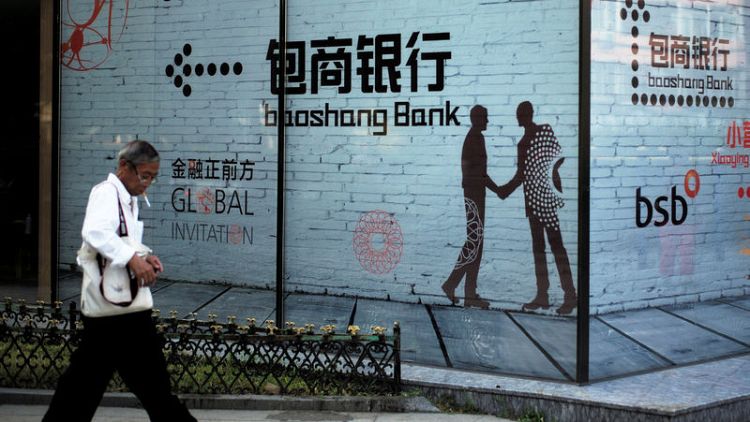By Cheng Leng and Ryan Woo
YINGKOU, China (Reuters) - Bundles of yuan notes were stacked high behind the counters of branches of Yingkou Coastal Bank earlier this month, as the northeast China lender fought off a run on deposits while onsite government officials battled rumours of a funding crunch.
Yingkou was the latest small bank to have its deposit-reliant funding base undermined by depositors, spooked by the funding crunch that led to the shock state-led rescue of tiny regional lender Baoshang Bank. To help repair the damage, Yingkou hiked its already high deposit interest rates.
The run came just as smaller lenders' reliance on deposits for funding shot up this year after Baoshang's rescue sent interbank interest rates spiking, raising borrowing costs.
Funding was already under pressure from government efforts since 2016 to de-leverage the financial system. Since August, government-mandated cuts in lending rates to shore up a slowing economy have only exacerbated the pressure.
With less income from lending and without the full suite of funding options available to much larger peers, the interest rates that China's legion of small banks may have to offer to attract deposits could further undermine their stability, analysts said.
Dai Zhifeng, a banking analyst with Zhongtai Securities, said the funding difficulties risked distorting small banks' behaviour.
"Lacking core competitiveness, some of them have turned to high-risk, short-sighted operations," he said, adding that a liquidity crunch was possible at some institutions.
At Yingkou, "untruthful rumours about the bank's deep financial crisis spread online", the city police said, triggering a run on deposits on Nov. 6 when a Reuters witness saw piles of cash behind counters at six city-centre branches.
The local government stepped in to allay concerns, placing officials at Yingkou's biggest branch to help calm depositors, and hanging notices saying the bank had sufficient assets and that its operations and management were in good standing.
Deposits made up 58% of Yingkou's funding as of June-end. In the wake of the run, it raised its rate for one-year time deposits to 4.4% from 4.2% and kept the rate on its flagship three-month wealth management product above 5%, showed marketing materials seen by Reuters.
By comparison, the popular money market fund Yu'ebao backed by e-commerce giant Alibaba Group Holding Ltd offers a 2% annualised rate, while China's benchmark rate for a one-year time deposit is 1.75%.
"I thought about the risks of smaller lenders, but an interest rate of 4%-plus on deposits was too attractive for me," said Sun Wensheng, a futures trader who deposited 420,000 yuan ($59,772.86) with Yingkou just before the bank run.
The China Banking and Insurance Regulatory Commission (CBIRC) did not immediately respond to a request for comment on the risk to small lenders from higher deposit rates. Yingkou did not respond to a request for comment.
LOCALISED RESCUE
Though small, problems at China's more than 4,500 local banks matter because of their close ties to larger lenders and huge base of mom-and-pop savers.
Yingkou was the second bank run in less than two weeks, following a panic at Yichuan Rural Commercial Bank in central Henan province amid a corruption investigation into a former boss.
But in contrast to the May rescue of Inner Mongolia lender Baoshang Bank, when a takeover by the central government sent interbank lending rates sharply higher, local governments took the lead in managing both of the latest scares.
The change in approach was deliberate and is now based on the specific situation of the bank in question, said an official at the Shanghai branch of the CBIRC.
In both runs, funding from other local banks was swiftly brought in to allay liquidity fears under instruction from the authorities.
"The current smaller banking industry is fragile due to (its) high leverage and poor liquidity management," said another regional CBIRC official who oversees local rural banks. "Smaller banks need to be treated carefully and problems rectified as they emerge, such as corporate governance, to avoid contagion risks."
For fear of squeezing a funding lifeline, regulators have refrained from cracking down on the high-return time deposits offered by small banks.
Local intervention should help contain problems and cut the cost of any rescue, said Rory Green, an economist covering China at independent investment research firm TS Lombard.
"That is long-term positive for China, but will create a lot of risks when local authorities don't have enough capital and don't act quickly enough to stabilise the situation," he said.
Regulators are also looking at recapitalisation, mergers and other forms of support.
On Nov. 18, Harbin Bank Co Ltd - a midsize lender with links to Baoshang stakeholder Tomorrow Holdings - saw its shares jump 9% after two local state-controlled groups became its key shareholders, paying an above-market price to do so.
(Reporting by Cheng Leng and Ryan Woo; Additional reporting by Sumeet Chatterjee in Hong Kong; Editing by Jennifer Hughes and Christopher Cushing)



